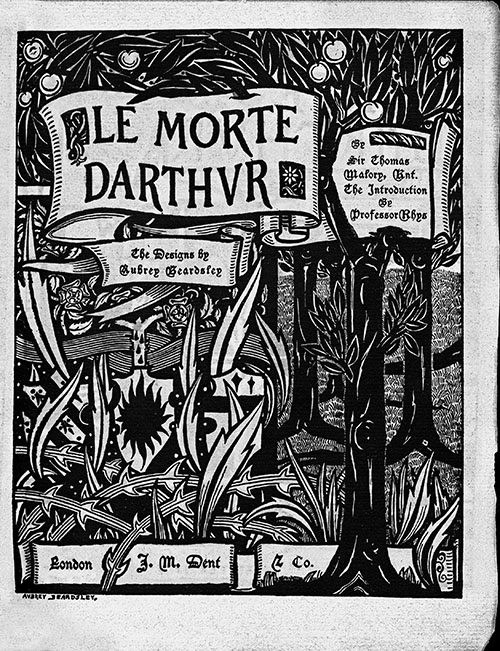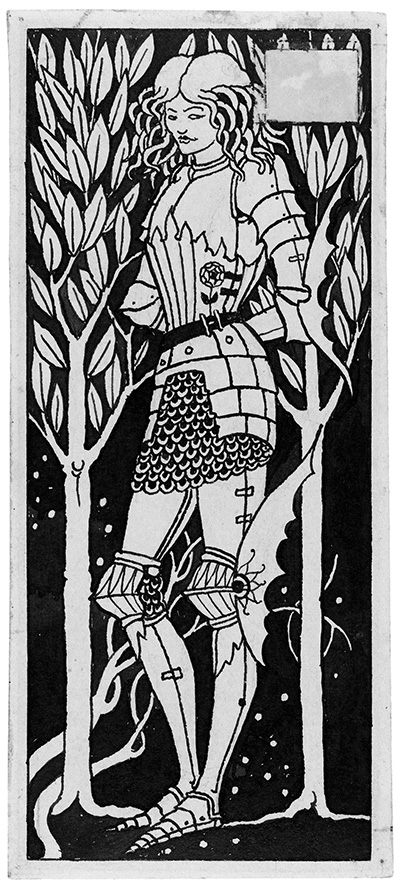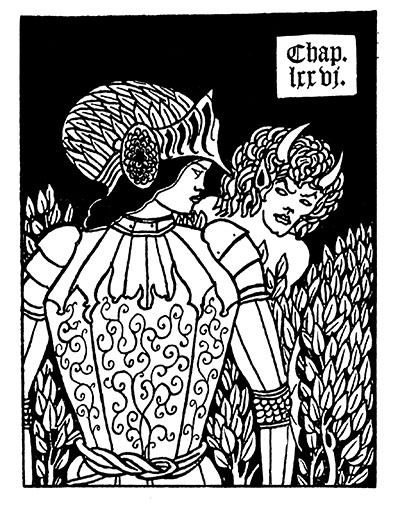Beardsley’s illustrations for J. M. Dent’s edition of the Morte Darthur (1893–4) have often been deemed to bear an unusually tenuous relation to the Arthurian narrative. Out of approximately 500 illustrations, only the 20 full-page illustrations address identifiable moments in the narrative. Although there have been convincing arguments for certain thematic and atmospheric connections between text and image, the view that Beardsley’s fantasy world is disconnected from Malory’s Camelot has been widespread since the publication of Dent’s Morte.
Despite their supposed inaptness to Malory’s text, Dent and his successors have continued to reuse the illustrations in subsequent editions of the Morte Darthur. In some instances, publishers have used Beardsley’s illustrations at moments coinciding with revivals of interest in the artist, or they have emphasised Beardsley’s paratexts to appeal to collectors of his work. In each case, the uneasy relationship between text and image does not seem to have discouraged the publisher’s use of them.

Dent began repurposing Beardsley’s illustrations as soon as 1898, in his Temple Classics edition of the text. The edition was published in four volumes, with four of the artist’s works featured as frontispieces (The Lady of the Lake Telleth Arthur of the Sword Excalibur, How Morgan Le Fay Gave a Shield to Sir Tristram, La Beale Isolde at Joyous Garde and The Achieving of the Sangreal). The focus of this piece, however, will be on the second and third editions of the 1893–4 Morte Darthur (1909 and 1927), the Morte Darthur Portfolio (1927), and the Everyman’s Library Le Morte d’Arthur (1974).
The second and third editions
The second edition of Dent’s 1893–4 Morte was published in 1909, the same year the Bodley Head published Robert Ross’s biography, Aubrey Beardsley. In August and September, the Baillie Gallery held an exhibition titled Drawings by Aubrey Beardsley, which featured 118 works by the artist, including some lent by Dent. Just over ten years after his death, Beardsley was still a popular subject for critics and authors. It was likely this sustained interest in the artist that led Dent & Co. to return to the 1893–4 edition, despite having since published a Temple Classics version of the Morte and three editions of the Everyman’s Library version.
The third edition, published in 1927, is an example of how Dent & Co. emphasised Beardsley’s paratexts to sell the Morte. In his notes to his father’s memoirs, Hugh Dent remarks that it was ‘rather more as the Aubrey Beardsley edition that we reissued the Morte d’Arthur in 1927’.[1] This new ‘Beardsley’ edition clearly emphasised the role of the artist; the title was extended to advertise the inclusion of ‘a note on Aubrey Beardsley by Aymer Vallance’. This ‘note’ retells the story of how the artist secured the commission to illustrate the Morte and analyses some of the drawings in detail. These biographical details situate the edition in the context of Beardsley’s career, awarding prominence to the illustrations and their illustrator rather than to the text and its author.
Furthermore, the edition boasted ten ‘new’ chapter headings that were not included in the first edition. These ten ‘extra’ illustrations were accidentally omitted from the first edition of the Morte due to a printing error. However, the blocks were used for the second edition, without it being noted by printer or publisher. It was R. A. Walker who realised these ‘extra’ illustrations existed. Subsequently, when the third edition was published, Dent & Co took the opportunity to advertise them. By consciously marketing the third edition in such a way, the publishers took advantage of this ‘cult of Beardsley’ to sell copies of the Morte Darthur.

The Morte Darthur Portfolio
In the same year as the third edition, Dent & Co. released the Morte Darthur Portfolio. This short book included the ten omitted designs and Vallance’s essay from the third edition, but additionally featured a facsimile print of the Merlin drawing, an unused chapter heading, drawings made for the cover of the issue in parts, and a note on the omitted designs by R. A. Walker. Designed for readers who already owned the Large Paper first edition, this ‘portfolio’ is another example of how Dent & Co. targeted collectors of Beardsley’s works. It was limited to 300 copies, the same number as the Large Paper first edition, and was identical in size and cover design to the first edition.
The portfolio was fashioned as a collector’s item, as evidenced by the publisher’s note, which emphasises how the book is ‘distinguished from its predecessors, so far as Beardsley is concerned’, due to the three illustrations ‘which have never before been printed with the Morte Darthur’. That this portfolio did not even include Malory’s text demonstrates how Beardsley’s illustrations for the Arthurian legend had surpassed the text itself. The uneasy relationship between text and image is exaggerated as, separated from their contexts, these illustrations become synonymous with their host text despite their supposed incongruity. The paratext is lifted to the same level as the text, as the publisher’s note claims that ‘this extra volume will, so to speak, complete [the buyer’s] set of the illustrated Morte Darthur’. The concept that the ‘set’ is not complete without Beardsley’s extra illustrations not only reveals the significance of the paratext in the eyes of the publishers but also demonstrates how the publishers used those paratexts to sell books.
The Everyman’s Library edition
The biggest revival of interest in Beardsley’s work came after the 1966 V&A exhibition of his art. This seminal exhibition brought Beardsley’s work back into the public eye and sparked a ‘Beardsley revival’. His artwork appeared on album covers, posters, fabric, stationery and even wallpaper (see the V&A collections website).

Brian Reade’s Beardsley was published in 1967 and the first comprehensive collection of the artist’s letters, edited by Henry Maas, J. L. Duncan and W. G. Good, was published in 1971. Stanley Weintraub’s biography Aubrey Beardsley was released in 1972 (re-published in 1976 as Aubrey Beardsley: Imp of the Perverse) whilst Simon Wilson’s Beardsley came a little later in 1976. Brigid Brophy’s Beardsley and His World was also published in the same year, though this is by no means an exhaustive list of Beardsley publications in the 1970s. This revival of interest in the artist’s work is likely what motivated Dent & Co. to use Beardsley’s illustrations from the Morte as cover art to their 1974 Everyman’s Library edition of the text.
The Everyman’s Library Le Morte d’Arthur had first been published in two volumes in 1906 and was frequently republished until 1979. The first few editions were published without cover art, until 1962 when work by Eric Fraser was used. Finally, in 1974, publishers lifted illustrations from Beardsley’s 1893–4 edition to serve as cover art. Interestingly, however, they did not select any of Beardsley’s full-page illustrations or the frontispieces but instead used two chapter headings.

The illustration used for the cover of Volume I depicts an effeminate and decidedly Burne-Jonesian knight with bat-wing armour and Medusan curls. The image used for Volume II portrays another feminine knight with decorative armour and a feather patterned helmet with a satyr leering behind him. The uneasy relationship between text and image surfaces in this cover art; the knights are not identifiable members of the Round Table and the presence of the satyr complicates the Christian nature of the text. Furthermore, as chapter headings, these illustrations do not engage directly with the narrative, as the full-page illustrations do. They do, however, have a pseudo-medieval atmosphere and subject, unlike some of the other chapter headings which were utterly detached from the narrative. Moreover, these illustrations are more characteristic of Beardsley’s later style than some of the earlier works in the Morte, such as The Lady of the Lake Telleth Arthur of the Sword Excalibur, which strongly resemble Burne-Jones’s woodcuts for the Kelmscott Press. These two chapter headings strike the balance between being appropriate enough to the narrative to serve as cover art, while also appealing to fans of Beardsley’s art. Dent & Co. transformed their Everyman’s Library edition of the Morte into Beardsleyana, using the artist’s popularity as a tool to sell Arthurian literature.

[1] Hugh Dent and J. M. Dent, The House of Dent 1888-1938 (London: J. M. Dent & Sons, 1938), p.283.